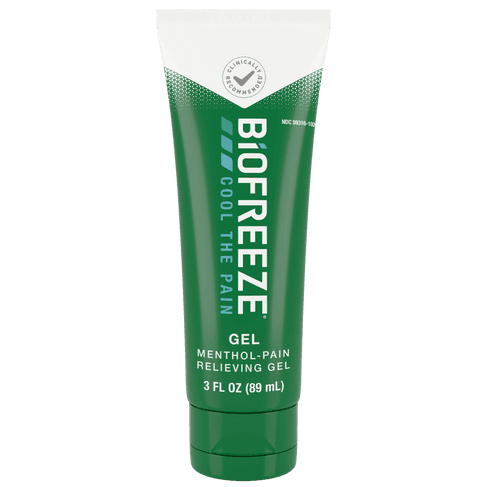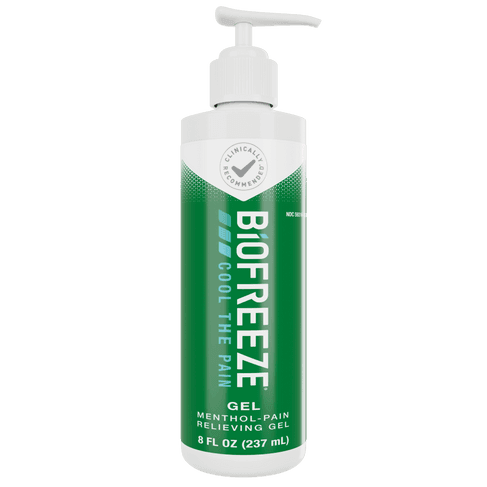Easy Application
Easily Covers Small & Large Areas
Targeted Relief

This article has been medically reviewed for accuracy
You've probably been told to apply ice to an injury after sustaining one. You've probably also heard that you should use heat, too.
Heat and ice are two commonly accessible pain relief treatments that you can do at home, but how do you know whether to use heat or ice on muscle pain?
In this guide, we cover the different pain relief properties of heat and ice, and when it's best to use them for your muscle pain.
Whether to use heat or ice depends largely on the cause of your muscle pain.
Is your muscle pain due to an acute soft tissue injury1 for example a muscle strain, or muscle bruising? Was there trauma to the muscle, resulting in impact or penetration of the muscle? Or is the pain simply due to soreness2A after an intense workout?
These are the questions you want to be asking yourself when deciding whether heat or cold therapy is the course of treatment. Heat and ice provide pain relief for different types of muscle pain,3A however, depending on the cause of the pain, heat may be more effective than ice, and vice versa.
In these next sections, we outline when to use ice and when to use heat on muscle pain, and when a combination of the two could be your best option.
Heat therapy is also known as thermotherapy. It involves raising the temperature of the affected muscle to induce muscle relaxation and pain relief.4A
Different forms of heat therapy include:4B
During heat therapy, the temperature of the skin and soft tissues increases. This activates the body's various thermoreceptors5A, dilating blood vessels6 and activating pain receptors5B.
Dilated blood vessels result in an increased blood flow7A,8A to the heated area. This helps flush out metabolic waste that is created as by-products of exercise9, and supplies the injured or affected muscle with oxygenated blood and nutrients.7B This may support muscle recovery10.
Heat can be beneficial for muscle pain4C caused by:
If the muscle pain or injury is accompanied by any swelling or inflammation, it is best to avoid the use of heat until the swelling and inflammation subsides.3B
Moist heat may also be helpful in managing pain related to osteoarthritis.3C Older injuries that have extended pain symptoms4D can also benefit from heat therapy.
Ice is a form of cold therapy that involves exposure to colder temperatures in order to relieve pain. This includes using ice packs, doing ice massages, or submerging in an ice bath4E. Other forms of cold therapy include cold air exposure, such as whole-body cryotherapy.
The application of ice lowers the skin's temperature at the area of application. This alerts the body's cold thermoreceptors5C to activate vasoconstriction activity11A This is when the blood vessels constrict, becoming narrower, which helps to reduce blood flow to the skin, conserving body heat.8B,11B
This vasoconstricting effect is particularly helpful in managing any inflammation and swelling that might occur after an injury. 11C,12 The narrowed blood vessels limit the flow of blood and other fluids to the injured area, minimizing swelling and inflammation surrounding the injury.
Ice application also impacts nerve conduction velocity, slowing the rate of nerve activity13A at the site. It can also slow the rate of pain signals firing in the brain14. This may be why ice application seems to decrease one's perception of pain, increasing both pain threshold and pain tolerance13B.
Ice may be beneficial in these scenarios4F:
To better manage symptoms of pulled muscles, see our guide on muscle strain relief here.
A combination of heat and cold therapy may be useful in the following cases:
Sore muscles caused by muscle strains and sprains may actually benefit from a combination of both hot and cold treatments. If you have any concerns regarding your muscle strain or sprain it is always best to speak with your healthcare provider.
Initially following the injury, ice may help reduce swelling, inflammation, and tenderness.
Health professionals recommend applying ice several times a day, in intervals of 20 minutes8C, or before the skin becomes numb. Applying ice for too long risks skin, tissue, and/or nerve damage.15
It's okay to use heat to injuries that have been bothering you for longer than six weeks. Increased blood flow helps to soothe sore joints and loosen up tense muscles. This is especially useful for increasing a joint's range of motion when that joint may not be moving as well.3D
Another scenario where you might benefit from using both heat and ice is when managing chronic pain that occurs without any significant swelling or loss of range of motion. Alternating between cold and heat applications allows you to reap the pain relief mechanisms of each therapy type, which will hopefully lead to sustained pain relief for your chronic pain.3D,8D
Easy Application
Easily Covers Small & Large Areas
Targeted Relief
Easy Application
Easily Covers Small & Large Areas
Targeted Relief
Heat and ice are great options for muscle pain relief, but here are other treatments you may find helpful to use in conjunction with heat and ice for muscle pain relief:
Biofreeze topical pain relief products come in a variety of forms, delivering pain relief for sore muscles and joints18. It may be used in conjunction with other forms of pain relief treatments, such as a massage.
This article has been medically reviewed for accuracy



Easy Application
Easily Covers Small & Large Areas
Targeted Relief
Easy Application
Easily Covers Small & Large Areas
Targeted Relief
